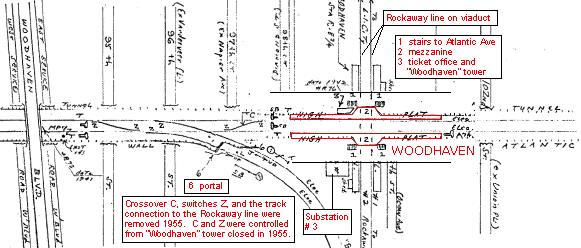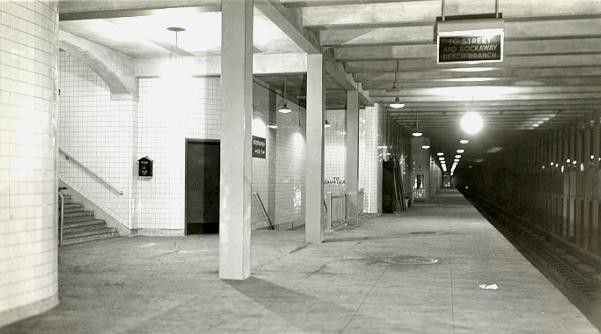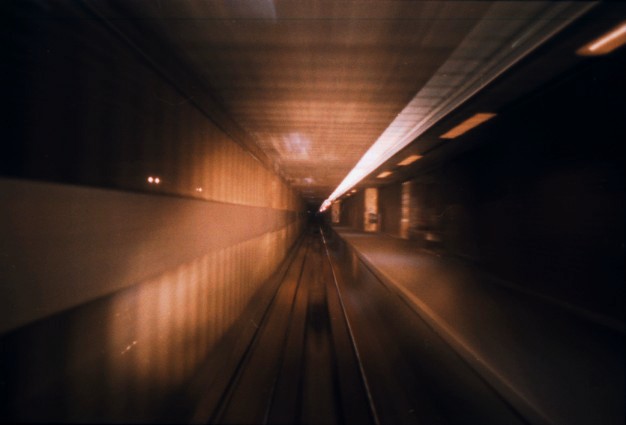

|
by Joseph Brennan. Copyright 2001, 2002. |
WoodhavenPassenger service: December 1942 - 1976.Existing abandoned portions: 2 platforms (on tracks in service). Touring: Look out the front window of any Long Island Rail Road train running on the line to Flatbush Ave, between East New York and Jamaica. construction and operationThe Brooklyn and Jamaica Railroad was the second railroad in what is now the City of New York, and has been operated since opening day in 1836 by the third railroad, the Long Island Railroad. The railroad east of Flatbush Ave was laid in the property of a turnpike company that the railroad purchased, and, to make a long story short, by 1900, the railroad was running in a private right of way down the middle of a city street, Atlantic Ave. At Woodhaven, a new railroad opened in 1881 crossing the Atlantic Branch at right angles. The New York, Woodhaven and Rockaway ran a service of trains from Long Island City to Rockaway Beach (now called Rockaway Park), using Long Island Railroad track for the first few miles. From the start, it ran on trestlework over the Atlantic Branch, avoiding a grade crossing, but there was a connection in the southwest quadrant for service from Brooklyn to Rockaway Beach. It was an all year operation but had far more service in the warm months. The crossing was known as Woodhaven Junction. Another station called simply Woodhaven was located on the Atlantic Branch less than a half mile west, at Woodhaven Boulevard, and trains made both stops. The Board of Atlantic Avenue Improvement, a joint project established between the City of Brooklyn and the Long Island Railroad in 1897, financed and built a combination of tunnels and elevated viaducts completed in 1903-1905 that got the railroad off street level in Brooklyn, except around East New York station and east of Atkins Ave. Thus the entire section in Queens Borough, through Woodhaven, remained at ground level for many years more. The tunnel through Woodhaven today, which runs from Snediker Ave (just east of East New York) to 121 St, was built starting in 1939 and was opened in December 1942. Woodhaven, at the former location of Woodhaven Junction, was the only station in the new tunnel. The other stations in this stretch were closed in 1939. Also ended in 1939 was the separate service of "local electric" trains that had run from Brooklyn to Queens Village at a lower price, a tradition that dated back to the "rapid transit" service of 1877 from Brooklyn to East New York. The new Woodhaven station looks much like an Independent Subway station. The tilework is of the same design, with a name mosaic WOODHAVEN. A curious point is that the Long Island Railroad had never purchased the Atlantic Branch, and that the owner company, through a chain of reorganizations and mergers, had become part of the BRT and BMT systems and had then been acquired by the City in 1940. Thus the new tunnel was a City project although the Long Island Railroad was the operator. Service to Woodhaven soon declined. Any use it may have had as a transfer to Rockaway trains was lost after 1950 when the infamous Jamaica Bay trestle fire ended service across the bay. The railroad's attention was firmly on commuters riding past Jamaica, and as each timetable appeared, fewer and fewer trains made the stop at Woodhaven. It finally closed in 1976. |
|
|

|
Robert Emery drew the vicinity of Woodhaven in 1959. The red notes are based on his handwritten notes on the sheet. The symmetry of the station plan is obvious, and its location directly below the crossing of the Rockaway Branch. The Atlantic Branch, left to right, is in tunnel while the Rockaway Branch is on viaduct built a few years earlier. The connection between them climbs from the tunnel portal shown. |
|
|


|
Excerpts from two timetables five years apart suggest the gradual reduction in train service. Allowing for alterations of a few minutes, overall service is about the same, but inbound from about 0830 to 1200, there were five trains stopping at Woodhaven in 1955 and only two in 1960. |

|
The underground station may have been renamed Woodhaven, but the tickets got stamped with Woodhaven Junction up to the end. How many people actually rode only from Woodhaven to East New York? They had pre-printed tickets for it. Ticket scan courtesy of Richard Makse. |

|
An old view of Woodhaven when it was open shows its similarities to a subway station. Photo copyright by Art Huneke. |

|
The only view of Woodhaven today is out the front window of a speeding train, illuminated by the headlights. Running westbound in July 2001. |